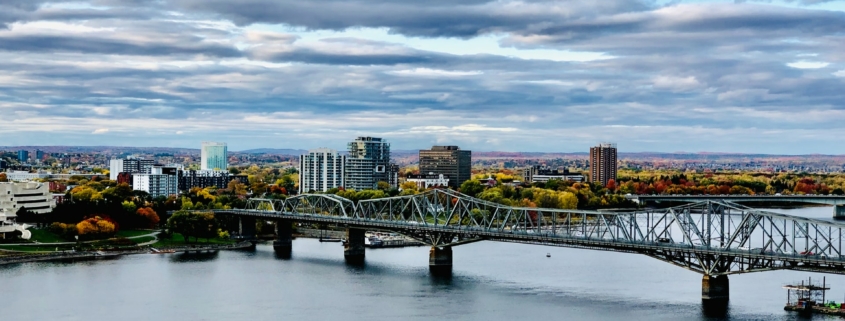Ottawa’s Ambitious Energy Evolution
In 2019, Ottawa City Council joined cities around the world in declaring a climate emergency and committed to reducing emissions to net zero by 2050. Today, City Council unanimously passed Energy Evolution—its plan for achieving that goal.
SSG and whatIf? Technologies performed technical analysis to help Ottawa identify what it will take to reduce greenhouse gas emissions from the City and community by 100% by 2050. The plan focuses on accomplishing these goals by reducing energy use through conservation and efficiency, increasing the supply of renewable energy through local and regional production, and prioritizing the procurement of clean renewable energy.
Energy Evolution details how the city can dramatically transform the energy system through actions in five key sectors: land use and growth management, buildings, transportation, waste and renewable natural gas, and electricity. For example, all fossil fuels will have to be phased out, 98% of existing buildings will have to be retrofitted, and all new buildings will be built with high energy efficiency standards. In addition, the public transportation system will be completely electrified and wind and solar power will meet local energy demand while offsetting emissions of the provincial grid.
We talked to two representatives from the City who have been closely involved with the plan. Janice Ashworth is on the City of Ottawa’s Climate Change and Resiliency Team, while Mike Fletcher is the City’s Environmental Program Manager. He has been involved in Energy Evolution since City Council’s 2015 motion to reduce GHG emissions 80% by 2050.
Why is Ottawa pursuing this plan?
Mike: It all started with public pressure—pressure on public officials and City Councillors, who first committed to an 80% cut in emissions by 2050. So, gradually, in the past ten years, the City has been taking measures, such as energy conservation targets and a green fleet strategy. But, as the public has become more informed about the science, there’s been greater concern and public pressure, leading to council declaring a climate emergency last year [April 24, 2019].
The outcome of the climate emergency is that we must have a 100% GHG-reduction scenario based on a carbon budget required to respect no more than one-and-a-half degrees of global heating. So it’s been a gradual, but steady, process.
The ultimate target of the plan is 100% GHG Reductions by 2050, but there are also interim targets for 2025, 2030, 2040, and specific actions that correspond to these years. What are some of those short-term actions and targets?
Janice: A long-term action is retrofitting 98% of all our existing buildings—commercial and residential—to a high degree of energy efficiency. We have to get 30% of the way there by 2030. That’s a pretty massive change that requires everyone in the city to work together. We also want to ensure new buildings are energy efficient as they’re built and get all new buildings to net zero by 2030.
We also have to change our transit system to 100% zero emissions by 2030. All new vehicles being sold by 2030 will all have to be electric, and there will be a gradual phasing out of existing gas cars. There’s many more in the five different sectors we’ve differentiated that have both short and long-term actions, and they all have their own trajectory for reduction over the next 30 years
That’s a massive transformation and undertaking. How much do you expect it will cost?
Janice: The plan is fully-costed, so we know exactly what the implementation of each action will cost. The total cost to society—so City costs and community costs—is $31.8 billion over the next 30 years. The really good news is that, over the lifetime of those assets we invest in, we see a return on investment of $87.7 billion, or $12.4 billion in today’s dollars. We see that net benefit because we’ll be so much more efficient, as a city and community as a whole. So there’s an economic development angle to the plan.
We can, of course, break that $31.8 billion down into each one of the actions in the plan, some of which have faster paybacks than others. We will use different financial mechanisms to finance different actions, so the City alone is not responsible for the $31.8 billion. The City’s direct responsibility for its own infrastructure and assets, such as building and transportation, equate to about $7.4 billion. The financial mechanisms are quite broad-ranging, from PACE [Property Assessed Clean Energy] funding for home improvement, to a community improvement plan to incentivize commercial building retrofits, to investments in local utilities.
How has Covid-19 affected the plan?
Janice: Well, there’s two positive sides to it. One is that people are commuting a heck of a lot less. So there’s already a significant reduction in emissions from that. It also leaves the opportunity for commercial buildings and office spaces, in particular, to be reconceived.
The other positive is that we are seeing an opportunity for massive federal stimulus funding. In the next few years, there will be a huge opportunity to take advantage of the funding that’s been channeled to Infrastructure Canada to get people back to work through the lens of a green recovery. So we’re really encouraged by that.
What excites you the most about the plan?
Janice: Difficult question! I’m both excited and anxious about it. Learning from experts has been pretty fun, but the tasks ahead are quite daunting. Like, how are we going to get this massive overhaul of more than 90% of buildings in the next 20 years? But that’s also what excites me the most, because there’s some really innovative analysis going on and it’s fun to be at the control center.
Mike: The challenge is so tough, you have to keep thinking “OK, how are we going to do this? How are we going to do this? I’ve got to think harder. That doesn’t get us far enough.” And we really have to keep thinking about it. So, it’s already led to innovation, whether in programs we’ve thought of or in terms of measures and technology that we can employ. That’s what gets me out of bed in the morning.
Ottawa’s Community Energy Transition Strategy, Energy Evolution, can be found here. To get in touch with us about how we can help your municipality reach net zero while transforming your economy and energy systems, contact us here.

 Photo by Alessio Patron on Unsplash.
Photo by Alessio Patron on Unsplash.

